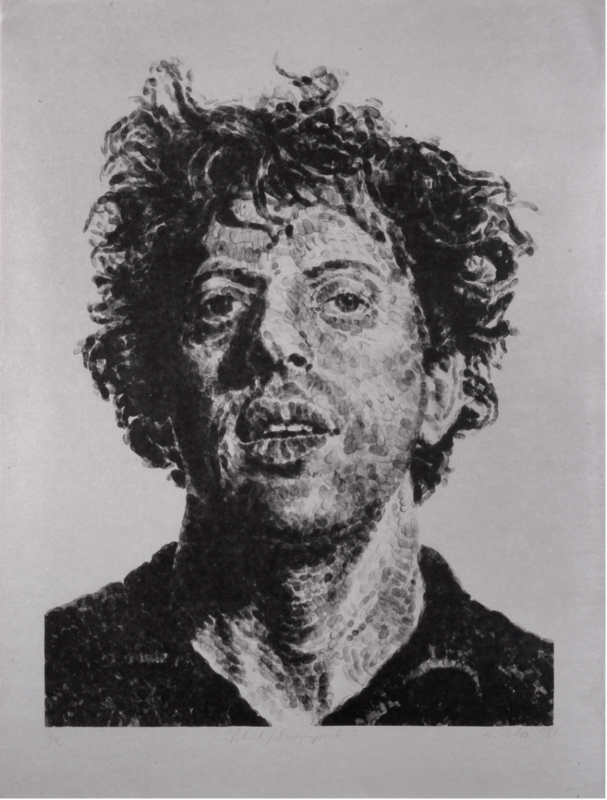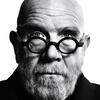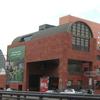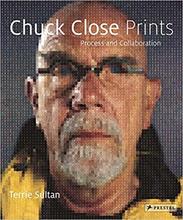More about Phil/Fingerprint
- All
- Info
- Shop

Sr. Contributor
Chuck Close belongs to that special group of painters known to boggle your mind with illusions.
Examining one of his works is always somewhat of a game. He allows you to get as close – pun intended – to the subject as you want, granted the museum guard doesn’t yell at you first, that is. Just as Bridget Riley made us question everything with optical illusions, many works by Close leave us wondering, “How in the hell did he do that?”
You might experience a bit of déjà vu when you find yourself looking at one of Close’s many portraits of his friend Philip Glass. It’s a friendship that runs pretty deep. Since 1968, Close has made 100 different studies of his friend, who is also a composer. Not to mention, all the different iterations of the portrait look pretty similar. They’ve all got the same trademarked, closely-cropped, head-on view. Even when these images aren’t nine feet square – this one, comparatively, is a mere four feet by three feet – Phil is a force to be reckoned with. In 2005, Phil finally returned the artistic favor with his own portrait. Phil performed "Musical Portrait of Chuck Close," a piano piece, at Lincoln Center in New York City.
Phil is by no means the only artist Chuck Close has chosen to be his subject matter. He has depicted artists and celebrities alike, including Jasper Johns, Robert Rauschenberg, Cindy Sherman, and Richard Serra, along with Brad Pitt and Alec Baldwin. He is friends with so many artists that he has been lovingly dubbed the Mayor of Soho, that achingly trendy Manhattan neighborhood to where so many artists and artist-types have flocked since the 1980s. He capitalized on his chummy relationships with all these people and became the first artist to specialize in portraits of his artist friends.
Phil/Fingerprint was an early exercise in this crazy idea that Close had – what would a painting made solely of fingerprints look like? Using his index finger as the brush, he varied the amount of ink used and the pressure applied to the paper to create the effects of different kinds of strokes of paint. By 1985, he got weirdly good with this technique and made a huge, strikingly realistic portrait of his grandmother Fanny made only with his fingerprints.
Despite their wow-factor, Close could no longer produce fingerprint paintings after injury and illness rendered nearly his whole body paralyzed in 1988. Because he no longer had control over his fine motor movements, Close began using a paintbrush strapped to his hand to allow for larger, gross motor movements. He transitioned to painting small grids of colorful brushstrokes that both mimicked the effects of the previous fingerprints and, yet, were starkly different.
Sources
- Artsy. “Biography.” About Chuck Close. https://www.artsy.net/artwork/chuck-close-phil-slash-fingerprint-3. Accessed June 12, 2018.
- National Gallery of Art. “An Eye for Art - Exploring Portraits - Chuck Close.” Learning Resources. https://www.nga.gov/content/dam/ngaweb/Education/learning-resources/an-…. Accessed June 12, 2018.
- Solomon, Deborah. “The Persistence of the Portraitist.” The New York Times. Magazine. February 1, 1998. https://www.nytimes.com/1998/02/01/magazine/the-persistence-of-the-port…. Accessed June 12, 2018.
- The Metropolitan Opera. “Gallery Met: Chuck Close Philip Glass 40 Years.” Exhibitions at the Gallery Met. https://www.metopera.org/Visit/Exhibitions/Gallery-Met-Exhibitions/Gall…. Accessed June 12, 2018.
- The Museum of Contemporary Art Los Angeles. “Phil/Fingerprint.” Collection. https://www.moca.org/collection/work/philfingerprint. Accessed June 12, 2018.
- Yoo, Alice. “Chuck Close’s Unbelievable Fingerpainting Portrait.” My Modern Met. Art. July 5, 2012. https://mymodernmet.com/chuck-close-fanny-fingerpainting/. Accessed June 12, 2018.













As everyone has a particular fingerprint so no one can steal other information and in most of the important and private places, fingerprint cheers are used, so this must be the most secure painting of all time.